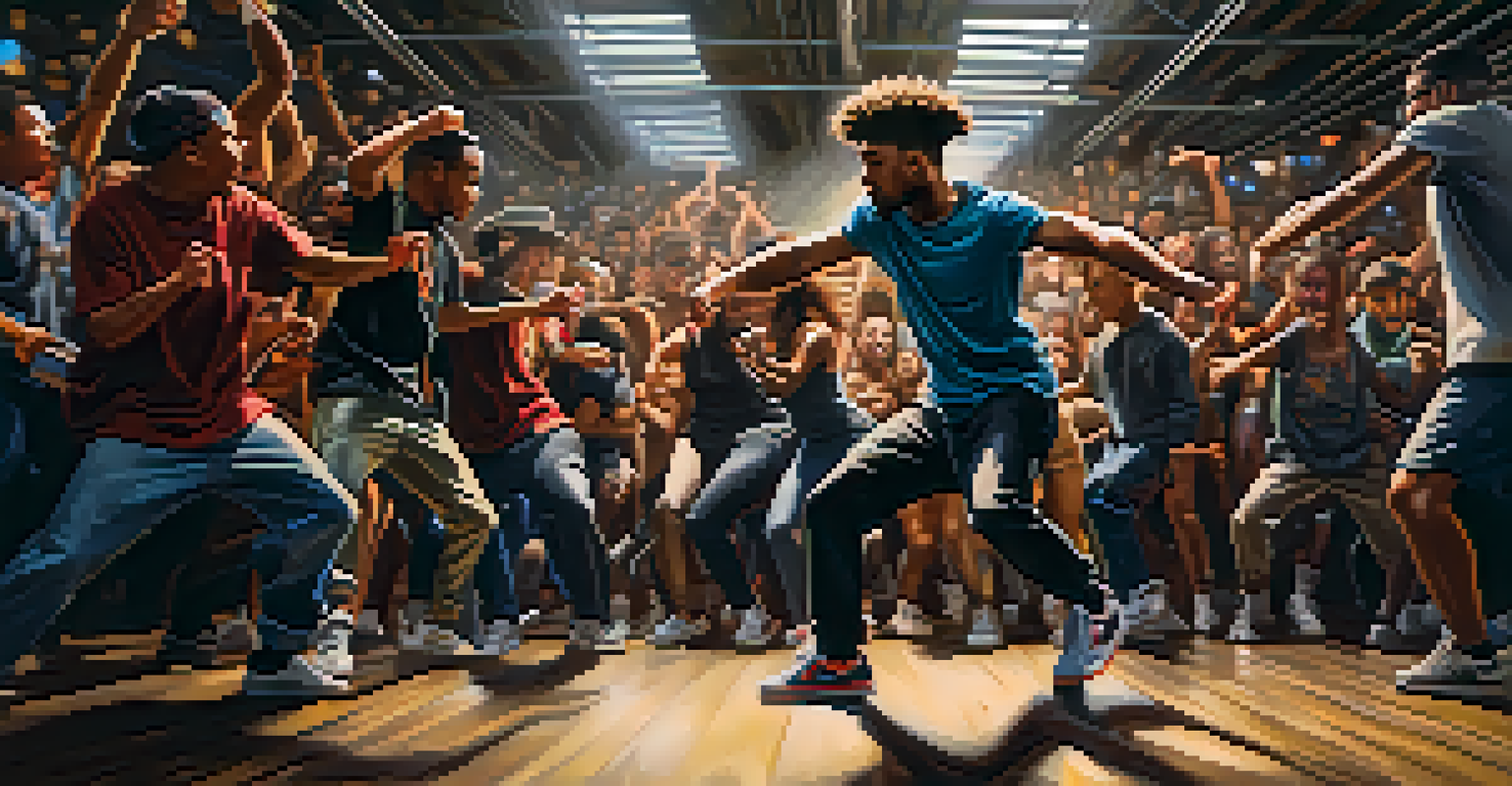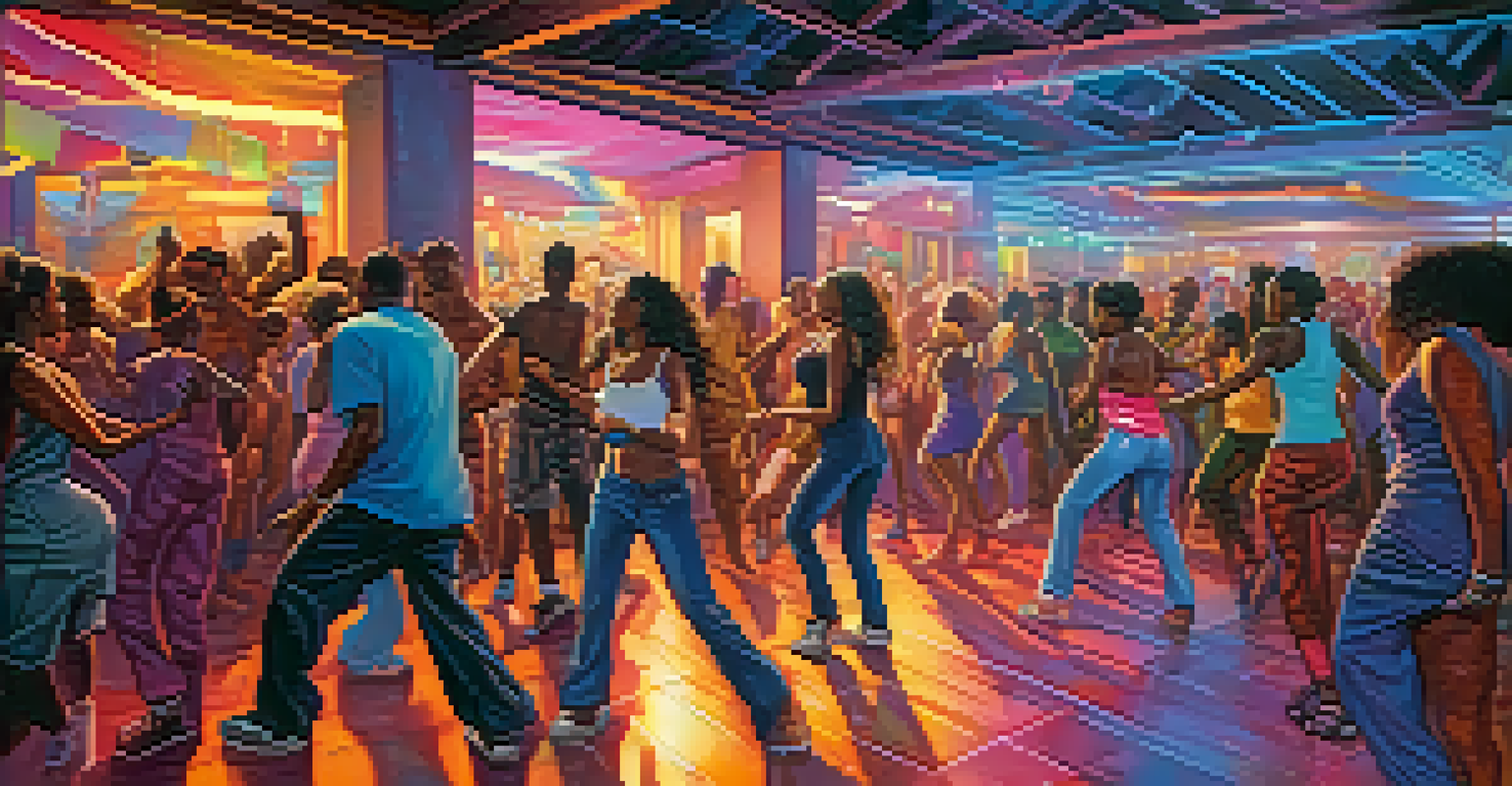Hip Hop Dance Styles: A Journey Through Their Evolution

The Birth of Hip Hop Dance: A Cultural Movement
Hip hop dance emerged in the 1970s, rooted in the vibrant culture of urban neighborhoods. It wasn't just a form of dance; it was a way for communities to express their struggles, joys, and creativity. The streets of the Bronx became the epicenter of this movement, where young people gathered to share their unique styles and stories.
Dance is the hidden language of the soul.
As DJs spun records, dancers began to create new moves that blended influences from various genres, including funk and jazz. This melting pot of styles gave rise to the energetic breakdancing we know today. Movements like the 'worm' and 'backspin' quickly became crowd favorites, showcasing the dancers' skills and individuality.
Hip hop dance wasn't only about the moves; it was also about the culture. With graffiti art and rap music providing the backdrop, these elements combined to create a powerful, expressive art form. This synergy helped lay the foundation for what hip hop would become in the years to follow.
Breaking: The Dance Style That Defined an Era
Breaking, or b-boying, is perhaps the most iconic hip hop dance style that emerged during the late 1970s. Characterized by its acrobatic moves and intricate footwork, breaking became a symbol of street culture. Dancers, known as b-boys and b-girls, often engaged in battles, showcasing their skills and creativity in a competitive yet supportive environment.

The popularity of breaking surged in the 1980s, thanks to its feature in movies and television. Films like 'Flashdance' and 'Beat Street' brought this dance style into the mainstream, inspiring countless individuals to learn the art. With its explosive spins and freezes, breaking captivated audiences and solidified its place in hip hop history.
Hip Hop Dance: A Cultural Expression
Emerging in the 1970s, hip hop dance became a vibrant way for communities to express their struggles and creativity.
As breaking evolved, so did its techniques and styles. Today, b-boys and b-girls continue to push the boundaries, incorporating elements from gymnastics and martial arts. This ongoing evolution keeps breaking fresh and relevant, ensuring its legacy within the hip hop dance community.
Popping and Locking: The Funk Styles Take Center Stage
Popping and locking emerged in the late 1960s and early 1970s, drawing inspiration from funk music and the burgeoning disco scene. Popping involves quickly contracting and relaxing muscles to create a jerking effect, while locking features exaggerated pauses and fluid movements. Together, these styles added a new dimension to hip hop dance.
Hip hop is the voice of the people, expressing the struggles and triumphs of life.
The funk movement brought these styles to the forefront, with dancers like Don Campbellock and Boogaloo Sam paving the way. Their innovative techniques not only captivated audiences but also influenced hip hop choreography as a whole. The energetic beats of funk music paired perfectly with these expressive dance forms, making them staples in hip hop culture.
Over the years, popping and locking have continued to evolve, incorporating elements from various dance genres. Today, you can find these styles in hip hop competitions, music videos, and even mainstream performances. Their adaptability is a testament to the creativity and resilience of hip hop dance.
Krumping: A Raw and Expressive Dance Style
Krumping is a high-energy dance style that emerged in the early 2000s, originating from the streets of Los Angeles. It is characterized by its exaggerated movements, including powerful stomps, chest pops, and dynamic arm movements. At its core, krumping is a form of self-expression and emotional release, allowing dancers to channel their feelings and experiences.
Unlike some other hip hop styles, krumping emphasizes raw emotion over technical precision. Dancers often engage in battles, showcasing their individuality and creativity through improvisation. This spontaneous nature of krumping creates a sense of community and connection among dancers, fostering an environment of support and encouragement.
Breaking: The Iconic Dance Style
Breaking, or b-boying, defined an era with its acrobatic moves and competitive spirit, becoming a symbol of street culture.
Krumping gained mainstream recognition through documentaries and performances, highlighting its cultural significance. As it continues to evolve, krumping remains a powerful testament to hip hop's ability to serve as a platform for personal expression and social commentary.
House Dance: The Fusion of Hip Hop and House Music
House dance emerged in the 1980s, blending elements of hip hop, jazz, and disco with the rhythmic beats of house music. This style is known for its fluid footwork, intricate body movements, and improvisation. House dancers often express themselves through a combination of grooves and rhythmic patterns, making it a unique counterpart to traditional hip hop styles.
The dance style gained momentum in underground clubs, where dancers would come together to showcase their skills. House dance is characterized by its emphasis on personal style and interaction with the music, encouraging dancers to find their rhythm and flow. This connection between movement and music is at the heart of the house dance experience.
As house music and dance continue to evolve, the influence of hip hop remains evident. Today, house dance is celebrated in competitions and dance battles, further solidifying its place within the hip hop community. This fusion of styles showcases the ever-evolving nature of dance and the ongoing dialogue between different genres.
The Rise of Hip Hop Dance in Mainstream Culture
In recent years, hip hop dance has seen a significant rise in popularity, permeating mainstream culture through television shows, movies, and social media. Programs like 'So You Think You Can Dance' and 'World of Dance' have introduced audiences to a diverse range of hip hop styles, showcasing the talent and creativity of dancers worldwide. As a result, hip hop has become a global phenomenon.
Social media platforms, particularly TikTok and Instagram, have further propelled hip hop dance into the spotlight. Dancers share their routines, participate in challenges, and create viral content, making hip hop dance accessible to a wider audience. This exposure has inspired many to take up dancing as a hobby or career, fueling the growth of the dance community.
Mainstream Rise of Hip Hop Dance
Recent years have seen hip hop dance gain popularity through television, social media, and its integration into popular music.
The integration of hip hop dance into popular music videos and live performances has also played a crucial role in its mainstream acceptance. Artists like Beyoncé, Bruno Mars, and Lizzo incorporate hip hop dance elements into their work, bridging the gap between music and dance. This synergy continues to elevate the status of hip hop dance within the entertainment industry.
The Future of Hip Hop Dance: Trends and Innovations
As hip hop dance continues to evolve, new trends and innovations are emerging in the dance community. Dancers are increasingly blending styles, creating hybrid forms that challenge traditional definitions. For instance, combining elements of ballet with hip hop techniques has opened up new avenues for expression and creativity.
Technology also plays a significant role in shaping the future of hip hop dance. Virtual reality and augmented reality are being used to create immersive dance experiences, allowing dancers to connect with audiences in innovative ways. Additionally, online dance classes and tutorials make it easier for aspiring dancers to learn from anywhere in the world.

The future of hip hop dance is bright, with new generations of dancers pushing boundaries and redefining the art form. As hip hop continues to intersect with various cultures and styles, it will undoubtedly maintain its status as a dynamic and influential aspect of contemporary dance.